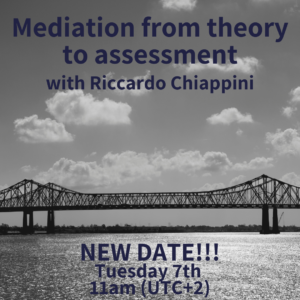It was wonderful to have Riccardo Chiappini joining us for the rescheduled webinar on mediation – and thankfully we didn’t have any technical problems this time! This is really a passion for Riccardo and he’s written numerous articles and presented on the topic of mediation many times. He also has a new book out now, written with Ethan Mansur, called Activities for Mediation: Building Bridges in the ELT Classroom. Check it out on the DELTA Publishing website.
As we mentioned during the webinar, mediation may seem like a relatively new term in ELT, but it’s actually something we’ve been doig for many years. However, there has been a recent push to make mediation more of a focal point and as one Hubster commented, “…mediation helps us REfocus on the communicative act. My own feeling is that tech and the bells and whistles of video, etc, has distracted the profession from this central part of language use. Ss need to be much more active agents when mediating.”
As Riccardo pointed out in the introduction, there is an intrinsic social aspect in mediation: the sharing of information, communication and building bridges. The information we’re sharing can come from any type of text, whether it be visual, audio, written or multi-modal. For example, a podcast would be audio input, an infographic combines a mixture of visual and written content and a film could contain all three if there are also subtitles or chunks of language to read onscreen alongside the audio and visual input. As well as mediating texts, the CEFR also talks about mediating communication and mediating concepts – areas which Riccardo gave sample tasks for as part of the webinar.
Mediating texts (5:30)
In this section of the webinar, Riccardo shared three ideas for working with texts: an art exhibition leaflet (written), a podcast (audio) and an inforgraphic (multi-modal). The tasks he suggests are carefully designed for the classroom and they give the learners a real-life reason for mediation and realistic target texts. For example, with the art exhibition text, you have to send a voice message to a friend to convince them to visit the exhibition with you.
For each task, Riccardo identified the strategies which learners will need to use and one key feature he mentioned of mediation during the webinar is that these are all transferable skills which learners will need to use in their own language as well: selecting and omitting, summarising, paraphrasing and taking notes, to name but a few.
Mediating concepts (26.00)
Here, Riccardo shared a task in which they have to transmit information from a subject in mainstream education to a younger audience. Riccardo mentioned how this is often seen within families – the way older siblings talk to their younger brothers and sisters by grading their language or changing the register.
In a group, each person is a mediator – sharing knowledge or reformulating the ideas of others within the group – and there may also be a ‘lead’ mediator who manages the discussion and task, bringing the group to a final decision.
Mediating communication (32.00)
In this case, we are helping two or more people to understand each other. There could be a difference in customs, values, languagues and so on and so a third person is needed to help mediate the situation.
For this task, which you can find in Activities for Mediation, Riccardo presented a role play in which there are three students staying in a host family. The host family member plays the role of the mediator and the other three students are each given a role: each one is from another country with particular food preferences and eating habits. The students must talk with the host family member to arrange what they would like to eat and when. The mediator then manages the interaction between their guests.
Riccardo also pointed out that we can support our learners either by pre-teaching the strategies they’ll need or by doing remedial work and providing opportunities for them to reflect on how they completed the task.
Assessment (48.00)
There’s no standardised method for assessing mediation as yet, but Riccardo and Ethan have outlined some ideas in their book. In the webinar, Riccardo expanded on what and how you could assess mediation. He suggested either the teacher or the students themselves could answer questions, refer to a rubric or analyse the CEFR level to evaluate their mediation skills.
One aspect of mediation that Riccardo highlighted was that it is communication and so learners will need to use language in any mediation task. However, he suggested that at the start, the focus should be more on the mediation aspect of a task rather than on using a task to incorporate particular language points. However, there may obviously be times when a linguistic problem impedes communication, in which case the mediation task won’t have been effectively completed.
As Riccardo mentioned in his conclusion, mediation is everywhere so it’s something authentic we can bring into our classes. If you’re looking for more ideas, Riccardo and Ethan’s book is jam-packed full of practical activities, as well as how you can adapt mediation tasks to the online classroom and ideas for setting up your own activities. You can also read more ideas from Riccardo in this article on mediation tasks for young learners or if you have a subscription to Modern English Teacher or English Teaching Professional he and Ethan also have articles published there.
